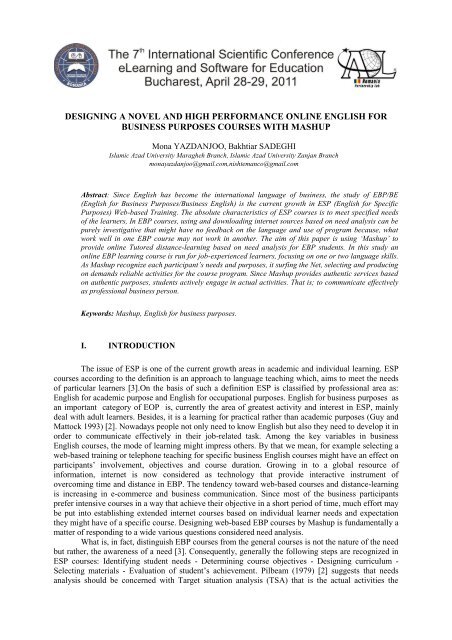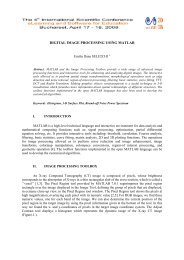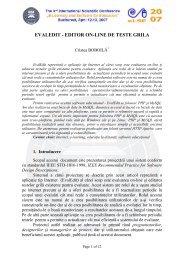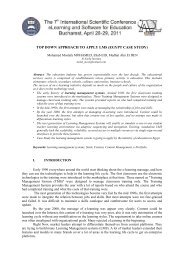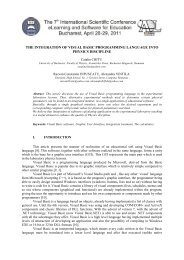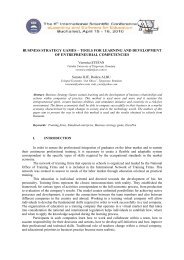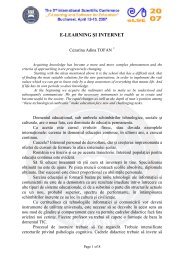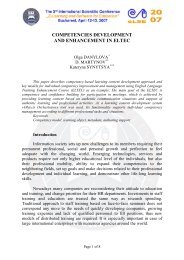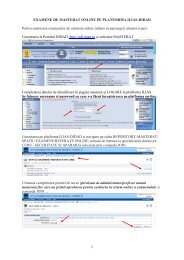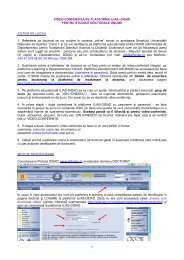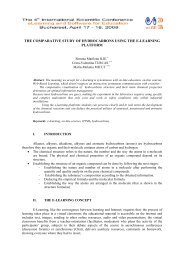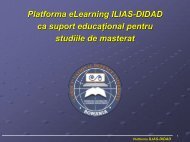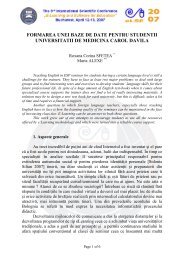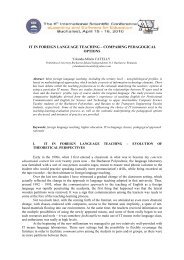designing a novel and high performance online english for business ...
designing a novel and high performance online english for business ...
designing a novel and high performance online english for business ...
Create successful ePaper yourself
Turn your PDF publications into a flip-book with our unique Google optimized e-Paper software.
participants have to carry out <strong>and</strong> personal abilities or participant proficiency which is evaluated orPresent Situation Analysis (PSA). Most of the participants in Business English are non-native speakersof English that based on TSA want to participate in global <strong>business</strong> language. Consequently, a precourseanalysis is essential <strong>for</strong> a successful EBP course, <strong>for</strong> the reason that, at the need analysis stagethe prerequisite in<strong>for</strong>mation that construct the foundation of training programs will be identify. Basedon the analysis, authentic <strong>and</strong> interactive activities that closely organized in the development of courseobjectives, will be construct. But if the learner recognizes some of the services <strong>and</strong> activities have notcontributed to the rapid advance of the learning process, there would be no way to adapt or change it.Besides, providing <strong>online</strong> authentic materials <strong>and</strong> services according to Business real situation requireda long period of analyzing. Web-based training based on authentic services is to some extent necessaryto EBP course because currently the new commercial transaction <strong>and</strong> Business commercials areconducting over the Internet.The present study is focus on: How EBP courses benefit from Mashup application in order toprovide <strong>high</strong> <strong>per<strong>for</strong>mance</strong> service <strong>for</strong> Business English students.The paper is organized in the following sections. First, we consider the challenges <strong>and</strong> issuesin the steps of <strong>designing</strong> EBP courses, the second section will devote to the technical framework <strong>and</strong>design of the software <strong>and</strong>, the final section include suggestion on the implementation of Mashup toolin EBP course.1.1 Issues in EBP course designConsidering the steps refer to in the previous part, one find out that behind successful EBPcourses is process of ascertaining what a course should contain? [3]. The answer directly related to thein<strong>for</strong>mation that can be available by need analysis, which is different in relation to student‟ perception.For example the course that is going to designed <strong>for</strong> <strong>business</strong> managers in a company can be muchmore varied than those in similar situation because the participants <strong>and</strong> consequently their needs havebeen changed. Due to this fact there are several methods that employ to need analysis. One of theprevailing methods especially <strong>for</strong> EBP courses is using questionnaires. The data gathering by thismethod require a computer software analysis. Nelson (1994) [2] starts with placement test <strong>and</strong> a needsanalysis questionnaire. The in<strong>for</strong>mation were processed by computer <strong>and</strong> the final results will bedrawn by using charts include needs <strong>and</strong> wants of the students. There is a manual override to thesystem at all stages so that teachers can influence the process [2]. Reeves <strong>and</strong> Wright (1996) [2]introduced LANA (LAnguage Needs Analysis). Again the software analyses the responses that isprovided by interviews, modeling, <strong>and</strong> a computer-based questionnaire [2]. The result will bepresented by a three dimensional histograms. Munby‟s Communicative Syllabus Design (1978) [2] isone of the well-known works on need analysis. Munby in order to find out target situation analysis usea set of procedures called Communication Needs Processor (CNP). It consists of a range of questionsabout key communication variables (topic, participants, medium etc.) which can be used to identify thetarget language needs of any group of learners [3]. There are a number of other procedures introducedby Jones „Principle Component Analysis (PCA), Mackay (1978), Cohen <strong>and</strong> Mannion (1980),Richterich <strong>and</strong> Chancerel (1980), totally they are listed as; questionnaires, interviews, consultation,observation, data collection [3]. So to establish a workable course design three important types ofneeds analysis need to per<strong>for</strong>m, TSA (Target situation Analysis), LSA (Learning situation Analysis),<strong>and</strong> PSA(Present Situation Analysis) (Dudley-Evans <strong>and</strong> St John 1998) [5].Generally speaking, the recognized methods are time consuming. If we want to provide<strong>business</strong> people with the services they need, some instruments is required to gathering in<strong>for</strong>mation inorder to know the participants. There is a direct relationship between objectives <strong>and</strong> student needs.Business English students either want to become more experienced in their job or study English <strong>for</strong>academic <strong>business</strong> study. It is essential to be aware of student‟s real goal. However, adapting activities<strong>and</strong> skills to the fulfilment of the goals might be dem<strong>and</strong>ing. Because instructional design should meetthe needs <strong>and</strong> preferences of the students. As we know the characteristic of <strong>online</strong> EBP courses islimited time. A <strong>business</strong>person is too busy that mostly they prefer not wasting too many time to reachtheir desired purpose. Determining <strong>and</strong> gathering in<strong>for</strong>mation is a matter, interpreting the answers isanother. With regard to where they need to be, we should conduct or interpret need analysis.Throughout these activities there might be misconceptions or false in<strong>for</strong>mation that may cause not tohave a clear definition of the purpose of the instruction. This fact enables students to reach the end
target <strong>and</strong> as a result of that the objectives may not be determined precisely. Consequently the requiredactivities <strong>for</strong> fulfillment of them will not be acceptable.Identifying <strong>and</strong> recognizing needs doesn‟t stop after the first step, but we should keepchecking „was that useful based on student need?‟ Tony Dudley-Evans <strong>and</strong> Maggie Jo St. John [2]suggest that analyzing authentic texts is a crucial stage of need analysis that is‟ Authenticity is theproperty of purpose <strong>and</strong> the level of the text that is the text should accompany with the purpose <strong>and</strong> thelevel of the students‟ [2]. That is, a text or activity which is organized or designed <strong>for</strong> Job-experiencedlearners will not be appropriate <strong>for</strong> a pre-job experienced. Moreover, authenticity in level, increaselearner‟s interests <strong>and</strong> motivation <strong>and</strong> there<strong>for</strong>e, encourage active participation of learners in usinglanguage <strong>for</strong> the determined purpose. Business English students require a course that improves theirability to use language <strong>for</strong> needs <strong>and</strong> goals. So, there might be tools to guarantee the authenticity ofpurpose <strong>and</strong> level of services. We recognize that implementing Mashup tool in EBP course design mayprovide a service that would facilitate learning Business English.1.2 Mashup <strong>and</strong> EBPThe technology revolution has brought many changes in on-line courses as a result of thatMost EBP courses are placed on the Internet <strong>and</strong> can be used by any students. In other wordsconsistent with broader trends in <strong>high</strong>er education, the delivery of education via the Internet has takenon increasing importance <strong>for</strong> <strong>business</strong> schools (Popovich & Neel, 2005) [9]. The general <strong>for</strong>mat <strong>for</strong>such courses is that learners follow them on their own. There are a number of web-based distancelearning services <strong>and</strong> applications designed <strong>for</strong> EBP students. With respect to the features of Webbasedlearning environment, most of them generally characterized as: meeting the needs of the users,selecting media regarding objectives, increase user‟s interaction, <strong>and</strong> speed learning. The significantfactor above all is that; they try to follow Learner-centered curriculum. That is, learners are incomplete involvement with their learning. Considering current websites of EBP courses, the coursesare originally <strong>for</strong> learning a variety of different Business subject matters through the effective use ofInternet technologies. They start instruction by completing need analysis <strong>for</strong>ms. It includesdetermining the level of students <strong>and</strong> specific area of their requirement. A list of multimedia activities<strong>and</strong> material are constructed in a set of units around needs of students.In con<strong>for</strong>mity with [1] generally, a Mashup comprises an application that combines multiplesets of data streams into a unified user experience. In relation to Web “Mashup” can be defined as asituational web application that extract <strong>and</strong> combines data <strong>and</strong> functionality from different sources tosupport user needs <strong>and</strong> tasks [7]. And finally with regard to e-learning, within the context of learningobject repositories, aggregation of in<strong>for</strong>mation junks is realized according to instructional models <strong>and</strong>on terms of st<strong>and</strong>ards <strong>and</strong> specifications, such as LOM or SCORM. In relation to EBP, We defineMashup as: an application that surf the Internet <strong>and</strong> integrate services based on your needs <strong>and</strong>dem<strong>and</strong>s. Using Mashup in EBP courses is concerned with Technology Acceptance Model (TAM).This model determine the number of factors have an effect on user‟s decision in using a newtechnology. One of these factors defined by Fred Davis as Perceived Usefulness refer to „the degree towhich a person believes that using a particular system enhance his or her job <strong>per<strong>for</strong>mance</strong> (Wikipedia).By using Mashup users benefit from various web-based tools <strong>and</strong> services. Since applying Mashup isbased on, combining services to support user‟s needs, the degree of Perceived Usefulness can be much<strong>high</strong>er in EBP web-based courses. In fact it is cooperation between services in order to provide aperfect outcome. Employing Mashup is a relatively new phenomenon among EBP web coursesbecause the course is not restricted to a set of ready-to-use bank of sources or activities which thewebsite designed <strong>for</strong> a particular subject, but it fetch other <strong>online</strong> services in terms that it support theuser dem<strong>and</strong>s, accordingly provide a list of activities or authentic material that allow different types ofBusiness English students (whether interest in marketing, management, etc.) benefit from the coursematerial.Two important issues in EBP courses mentioned be<strong>for</strong>e as; authenticity of purpose <strong>and</strong>authenticity of level is supported by Mashup. The need analysis <strong>for</strong>m is provided <strong>for</strong> recognizing TSA<strong>and</strong> the level of learners <strong>and</strong> utilize as repository <strong>for</strong> Mashup to merge the services into one webapplication.Mashup help English <strong>business</strong> learners to find the most appropriate materials that improvetheir job knowledge skills .For Business English learners taking part in courses with determined
outcomes will be <strong>high</strong>ly motivating. In fact Mashup create a community of <strong>online</strong> services based onBusiness English‟s dem<strong>and</strong>.The aim of this project is first, to develop a Mashup framework <strong>for</strong> EBP courses as onesolution to problems in web-based EBP need analysis, <strong>and</strong> second, to construct a web-based courseaccess authentic activities <strong>and</strong> text with a minimum of ef<strong>for</strong>t that exploit instructional <strong>online</strong> tools <strong>and</strong>services to integrate them <strong>for</strong> a useful <strong>online</strong> course. We hope this new study develop the applicationof Mashups <strong>for</strong> EBP courses.II.METHODOLOGYIn current study Mashup tools apply <strong>for</strong> web-based EBP course. The great advantage of suchan application is that there is no need to spend on need analyses or interpreting data <strong>for</strong> the reason ofestablishing an appropriate design <strong>for</strong> <strong>online</strong> EBP course. But, as the students „requirements of thecourse is recognized by the software, it surf the Internet services render activities which best match tothe needs of the learner. Besides, learners are not restricted to some types of pedagogical activitiespresented by one web-service but they exploit similar activities in other <strong>online</strong> services or websites.Learners are in direct interaction with the software, so that they can control their own learning pace.Such involvement of learners offer a new instructional environment in on-line EBP courses. Themethodology of this study is discussed in such an order: Technical design <strong>and</strong> the structure of thesoftware, Integration of Mashup with EBP on-line course <strong>and</strong> the final section is a sample testify.2.1 Technical design <strong>and</strong> the structure of the softwareThe software design is conducted under a triple-ware schema to achieve in<strong>for</strong>mation <strong>and</strong>filtered data from the internet <strong>and</strong> related services must to be merged <strong>and</strong> provided as an interface toend user. Figure 1 provides an explicit explanation about the triple-ware schema. It shows a completedata flow of the in<strong>for</strong>mation from the beginning of the process to its end.Figure 1. Triple-ware schemaThe Triple-ware schema‟ function follow these steps: First, we design a script in EMML(Enterprise Mashup Markup Language) language to invoke data from the web by using web servers- inour proposed solution is tomcat 5.5- <strong>and</strong> the implementation backplane of Mashup. The engine usesJDK (Java Development Kit 1.5) on the windows plat<strong>for</strong>m.After that Mashup apply <strong>for</strong>ced script to surf the net <strong>and</strong> web services to fetch data. The outputfile will be created in this step; data presented in the XML (Extensible Markup Language) <strong>for</strong>matcontain some elements with optional attributes. So, XML file will be available to use, the elements actas input <strong>for</strong> the next step. The third step is the main part <strong>for</strong> the users, which is the implementation ofsoftware in the .Net environment by C# language programming to fetch data from the XML file as aninput feed in the special <strong>for</strong>m. It is done in a friendly design to be used by learners. In this step the userrequirement will be asked. According to it Mashup outline short abstract so that the proper data will beavailable <strong>for</strong> the user. If any of the in<strong>for</strong>mation does not satisfy the user, the URL (Universal Resourcelocator) can be clicked to gain extra in<strong>for</strong>mation in order to show the original source of data.2.2 Integration of Mashup into EBPThe course is proposed <strong>for</strong> intensive web-based EBP courses, respectively run <strong>for</strong> jobexperiencedstudents who bring <strong>business</strong> knowledge <strong>and</strong> skills to the language-learning situation. Thenature of the course is mainly focus on the learners as a main source of need analysis. Some pre-coursein<strong>for</strong>mation is obtained by completing a short <strong>for</strong>m of questionnaire. The approach <strong>for</strong> <strong>designing</strong> theEBP course is the integration of skill-centered <strong>and</strong> learning-centered approach. The <strong>for</strong>mer makes the
learning situation dependent on the target situation analysis. The learner is used to identify <strong>and</strong> toanalyze the target situation. It provide opportunities <strong>for</strong> learners to employ <strong>and</strong> evaluate the skills <strong>and</strong>strategies considered necessary in the target situation [3]. The latter consider interest, enjoyment,learner involvement influence the entire course [3]. In this study not only <strong>high</strong>light the importance oflearners preference <strong>and</strong> involvement in selecting their own activities but also the appropriate skills <strong>and</strong>exercises is presented to cope in target situation. The process of need analysis <strong>and</strong> lay down courseobjectives is h<strong>and</strong>led by the learners. That is the course objectives that have been laid down areappropriate <strong>for</strong> learner.Figure 2. Screenshot <strong>for</strong> start pageThe curriculum design of the course conduced in Mashup is as follows:Need analysis: West argues that an essential feature of a good needs analysis is that it takesinto account the preferences of the learners in terms of both what to learn <strong>and</strong> styles of learning (1997)[11]. So in this level the learner complete a <strong>for</strong>m which is similar to a questionnaire, in addition theyshould study <strong>and</strong> fill it in carefully. It is designed on the basis of learners „need of the course, level,<strong>and</strong> objectives they assume to be able to carry out as the result of training. For example „to be able towrite effective <strong>business</strong> report‟. By completing the <strong>for</strong>m in fact the objective of the course isdetermined too.Fetching links: Unlike other methods, the in<strong>for</strong>mation analysis <strong>and</strong> interpretation <strong>for</strong> <strong>designing</strong><strong>and</strong> determining appropriate activities will be managed by the software. The in<strong>for</strong>mation that is gainedduring need analysis is employed to Mashup. Having completed the <strong>for</strong>m the learner click the invokebottom (Figure 2). The invoke bottom make Mashup to surf the Internet, in other words fetch the<strong>online</strong> services <strong>and</strong> activities related to <strong>online</strong> EBP services <strong>and</strong> websites. In<strong>for</strong>mation provided by thestudent in the previous step is the only factor taken into account by Mashup to fetch the Web servicesthat include text-based or html-<strong>for</strong>matted documents, or <strong>online</strong> activities. This means that, the outlinedactivities are best matched to learners „level, course objectives, <strong>and</strong> above all learners‟ specific needs.Activities <strong>and</strong> links will be appeared in the “fetching List” (Figure 3).Selecting Activities: We can relate this step to the complete involvement of the student <strong>for</strong> tworeasons: first, they identify <strong>and</strong> select activities from fetching list. Most of the students in this stepneed activities to improve their language skills. On the other h<strong>and</strong>, Since the selection of activities iscarried on according to the needs of a particular student, the “fetching list” provide a short snippetsabove each link <strong>and</strong> activities to show a coherence between the needs of students <strong>and</strong> the curriculumstructure. Reading that short snippet ensure that the course provides adequate <strong>and</strong> appropriate coverage
of activities to achieve their end. Second, users of EBP course identify their own pace of learning.Having read the snippets, learner confirms it or click on next button to see the following URL. There isa timetable button on the right side of “fetching list” that <strong>business</strong> user can establish an order <strong>for</strong> thecourse based on confirmed services <strong>and</strong> a schedule to practice the activities.Evaluation <strong>and</strong> assessment: A <strong>for</strong>mative evaluation takes place during the lifetime of thecourse [2]. A mini-evaluation undertake in the middle of course <strong>and</strong> the final evaluation at the end ofthe course. The advantage is that if the mini-evaluation doesn‟t show positive achievements within theparticular activity in fetching list, the student can select another. The evaluation button is located intimetable windows which enable students to avoid less successful aspects in course.2.3 The studyFigure 3. Screenshot <strong>for</strong> Mashup s‟ fetching listIn this section we just try to testify the course in relation to individual users. Participants inthis study were ten job-experienced Iranian students. All 10 participants took part in the studyvoluntarily. Some of them were students in an English Language Learning Centre. Four of participantswere computer engineers, one bank teller, <strong>and</strong> five accountants. A checklist proposed by Clarice S.C.Chan [10] was applied <strong>for</strong> evaluating Mashup functions on the basis of EBP pedagogical considerationto illustrate the value of Mashup component according to the requirement <strong>for</strong>m. Each of theparticipants completed the need analysis <strong>for</strong>m then clicked on the invoke button. Considering thefetching lists, general observations include the following:· The majority of services were suitable <strong>for</strong> job-experienced learners.· Most of the materials closely fit learner‟s needs that were <strong>high</strong>ly motivating.· Access to authentic material was easier <strong>for</strong> the learners <strong>for</strong> example in the case of the needto „negotiate in stock market „some financial news headline from Yahoo! was fetched.· It provides wide choices over activities <strong>and</strong> services in relationship to learners„professional practice.· It establishes multidisciplinary URL. For example some new models of trades <strong>and</strong>electronic commerce that enhance competitiveness of Business English learners werepresented in fetching list.According to these finding we realize that Mashup in <strong>online</strong> EBP courses is easy enough <strong>for</strong> areal course implementation. It promotes <strong>online</strong> learning <strong>and</strong> creates a supportive environment <strong>for</strong> EBPlearners.
IV.CONCLUSIONSConsidering the recent movement toward <strong>online</strong> web-based l Business English courses <strong>and</strong> thedevelopment of international contact, Users of EBP courses need to use English so that they canachieve more in their job <strong>and</strong> in e-commerce. In this study, we tried to propose a workable web-basedtraining based on Mashup that allows self-directed, self-paced learning in any topic related to BusinessEnglish. Each step of <strong>designing</strong> has focused on meeting the needs of the user. The basic innovation inthis paper is applying Mashup <strong>for</strong> <strong>designing</strong> Business English web-based training that dynamicallyadapt to the user needs. The course is not restricted to a specific service but, it can benefit from various<strong>online</strong> services or authentic activities available in search engines to enable the users to communicateeffectively in their job. The issue based on Mashup is still open to discussion, especially in exp<strong>and</strong>ingcourses <strong>for</strong> pre-experienced users or the number of participants to run the course <strong>for</strong>.AcknowledgementsThe first author would like to thank her devoted husb<strong>and</strong> <strong>for</strong> his comments on this study. Theauthors wish to acknowledge Dr.Farzad Salahshoor <strong>for</strong> motivating his students towards innovations<strong>and</strong> researches on <strong>online</strong> EBP courses.References[1] Kulathuramaiyer, N, 2007. Mashups: Emerging Application Development Paradigm <strong>for</strong> a Digital Journal. In:Journal of Universal Computer Science 13(4), 531-542(2007).[2] Tony Dudley-Evans <strong>and</strong> Maggie Jo ST John, 1998. Development in English <strong>for</strong> Specific purposes, CambridgeUniversity Press. United Kingdom, 7th edition.[3] Tom Hutchinson <strong>and</strong> Alan Waters, 1987. English <strong>for</strong> Specific purposes a learning - centred approach, CambridgeUniversity Press. United Kingdom, pages 91.[4] Mark Ellis <strong>and</strong> Christine Johnson, 1994. Teaching Business English, Ox<strong>for</strong>d University Press.[5] Slavica Cepon, 2005, Business English in practical Terms, Scripta Manent(1) 45-54, page 52.[6] Zuocheng Zhang, 2007. Towards an integrated approach to teaching Business English: A Chinese experience. In:English <strong>for</strong> specific purposes 26(2007)399-410. Available <strong>online</strong> www.ScienceDirect.com, page 402.[7] D. Merrill. Mashups: The new breed of Web app. 2006.[8] Krassen Stefanov, Roumen Nikolov Faculty of Mathematics <strong>and</strong> in<strong>for</strong>matics, University of Sofia, page 4.[9] J.B. Arbaugh, Michael R. Godfrey, Marianne Johnson, Birgit Leisen Pollack, Bruce Niendorf, WilliamWresch.Research in the <strong>business</strong> disciplines: Key findings <strong>and</strong> possible future directions <strong>online</strong> <strong>and</strong> blendedlearning.[10] Clarice S.C. Chan, 2009. Forging a link between research <strong>and</strong> pedagogy: A holistic framework <strong>for</strong> evaluating<strong>business</strong> English materials. In: English <strong>for</strong> Specific Purposes 28 (2009) 125–136, available <strong>online</strong>. www.ScienceDirect.com, pag 1.[11] Shu-Chiao Tsai, 2010. Developing <strong>and</strong> integrating courseware <strong>for</strong> oral presentations into ESP learning contexts. In:Computers & Education 55 (2010) 1245–1258, journal homepage: www.elsevier.com/locate/compedu[12] Erhard Rahm, Andreas Thor, David Aumueller. Dynamic Fusion of Web Data, University of Leipzig, Germany,http://dbs.uni-leipzig.de,5th International XML Database Symposium, XSym 2007, Vienna, Austria, September 23-24, 2007 Proceedings pag14.[13] Andreas Thor, David Aumueller, Erhard Rahm, 2007. Data Integration Support <strong>for</strong> Mashups, University of Leipzig,Germany, Copyright © 2007, Association <strong>for</strong> the Advancement of Artificial Intelligent (www.aaai.org).


